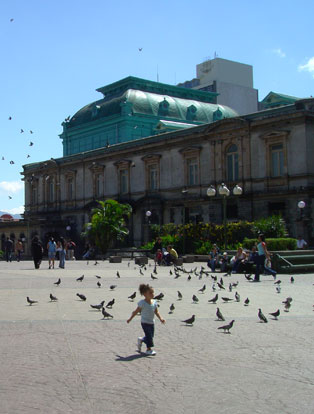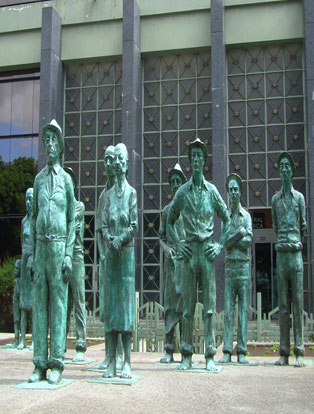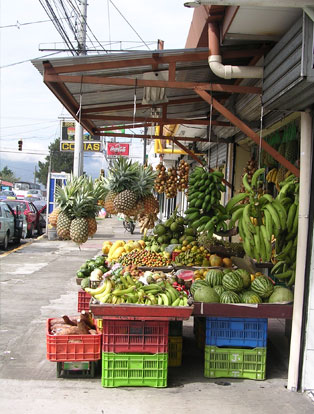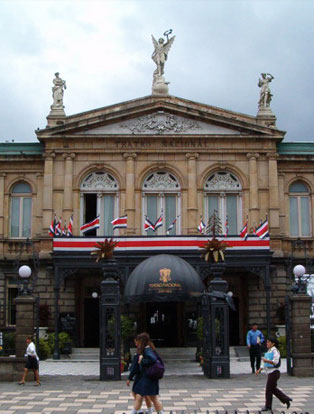
Retired globetrotters settle down for an extended stay at ILISA
Lankaster Gardens – A walk through Costa Rica’s Ecosystems
Volunteer work in Costa Rica with Habitat for Humanity
Cookery Corner – Arroz con Leche
Retired globetrotters settle down for an extended stay at ILISA
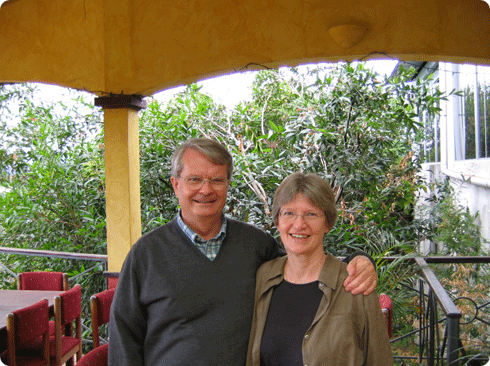 SAN PEDRO, COSTA RICA — Having traveled the globe and lived in eight different countries, Gayle and Roger Halpin keep a distinct view on languages. And they know quite well how even a little bit of language can lead to a magnificent cultural experience.
SAN PEDRO, COSTA RICA — Having traveled the globe and lived in eight different countries, Gayle and Roger Halpin keep a distinct view on languages. And they know quite well how even a little bit of language can lead to a magnificent cultural experience.
While traveling last year in Tunisia during the Muslim holiday of Ramadan, the now-retired Halpins were bystanders to an age-old ritual as they watched the local children frolic with a herd of sheep. In a short time, the sheep were to become the holiday feast.
Gayle, recalling her years of high school French instruction, asked a local man if the children were saddened by the prospect of playing with the soon-to-be supper.
“Better the sheep than the children,” he told them. Then, in French, the man invited them to partake in the Ramadan rituals. Soon, the Halpins were witnessing the slaughtering and cooking of the holy meal, which commemorates the Sacrifice of Ibrahim, and dining with a Tunisian family of 13 – with Gayle’s high-school level French serving as the bridge between the family and the visitors.
“It was wonderful,” Gayle says.
“You get so much more out of travel when you can communicate with and participate in the lives of the people of the countries you are visiting,” adds Roger.
Drawing on their knowledge of cultures, the importance of language and a desire to travel South America, the Halpins enrolled in ILISA Spanish Institute in Costa Rica for two weeks this year. Then, two weeks became three. Three became four, and so on. In the end, they spent seven weeks at ILISA (during which time they became known as the school’s most vigorous studiers and most reliable happy-hour attendees).
“I have more than exceeded my expectations,” says Roger. Knowing very little Spanish when he arrived, the former computer specialist for Mobil Oil has now achieved both of his main goals: to read a newspaper and to have a conversation in Spanish on the street. And, he has enjoyed ILISA’s custom-built building, nestled in the San José suburb of San Pedro.
“I don’t think you really appreciate it until you are here, but the facilities are so important to learning,” he says while he and Gayle enjoyed a splendid view of the Costa Rican mountainside from one of ILISA’s tranquil, glass-walled classrooms.
“We didn’t think, quite honestly, we could do four weeks. Now we’re doing seven,” says Gayle.
They first heard about ILISA when Roger was doing volunteer work in Venezuela. Gayle was taking a course at a school in Caracas when a student who’d studied at a number of language schools mentioned that ILISA in Costa Rica is the best language institute around. They also talked to a friend of Roger’s sister, who spoke highly of her 10 weeks at ILISA.
Lastly, they contacted three couples from ILISA’s reference list, all of whom gave glowing accounts of their time at the school. “I always have this need to have a personal recommendation before I do something.”
When asked to sum up their experience at ILISA, the couple had a simple answer: “Excellent.”
And that’s probably why the two months they’ve stayed at ILISA have been the longest they’ve ever remained in one location in all their years of traveling the world. Now, it’s off to Nicaragua for the adventuresome couple.
ILISA Spanish School in Costa Rica has been teaching Spanish to students of all backgrounds and nationalities since 1987. Its beautiful facilities and professional instructors have given ILISA the reputation as one of the best Spanish language schools in the world.
Contact the Halpins to hear more about their experience at ILISA: rfhalpin@excite.com or 202.338.7011
For more information about ILISA or to enroll, please contact us at spanish@ilisa.com or (1)8004547248.
Lankaster Gardens: A Walk Through Costa Rica’s Ecosystems
Lankaster Gardens, which is run by the University of Costa Rica’s biology department, is a haven for plant lovers and others who are looking to spend relaxing day in a lush, green environment.
Visitors can start by walking through gardens featuring plants typical of Costa Rica. This main area of the garden features walking paths, several fountains, and plants of all types. The showcase of the garden is a large greenhouse dedicated just to orchids. The variety is astonishing-there are hundreds of species! The display is particularly spectacular during the peak season for orchids, March and April. However, orchids are just the start.
After the green house, you can take a long walk through areas dedicated to different types of plants (i.e. palms, bamboo, bromeliads) and to ecosystems (i.e. desert; rainforest). Paved footpaths wind through the areas, making exploration on your own extremely accessible. There are also plenty benches where you can rest or just ponder the beauty of the gardens. The design of the park makes you feel as if you were truly immersed in different ecosystems.
Children will also love the freedom they have to explore the area. The diversity of the collection is impressive as is the garden’s impeccable maintenance. While the gardens appear small from the outside, you will need several hours to see everything. If you plan on reading all the information that is provided and studying all the plants that are marked, you could easily spend an entire day.
The gift shop/bookstore carries a wide collection of books on local and regional flora. You might purchase a guide for reference to make your stay even more enjoyable.
Lankaster Gardens is located several miles outside of Cartago. To get there, take a bus to Cartago, then a taxi from Cartago to the gardens. If you prefer, many package tours combine Lankaster Gardens with a visit to the Orosí Valley.
Volunteer work in Costa Rica for Habitat for Humanity
When Foster and Diana decided to put their lives on hold in the USA for a year to learn Spanish with us and then to travel, they also had the intention of giving a little back to Costa Rica by undertaking volunteer work with the international organization Habitat for Humanity.
Diana found the criteria for helping the non profit organization via Global Village a little too restrictive for their particular needs when she inquired in the States. “We couldn’t commit to 100 hours of volunteer work upfront and we needed the flexibility to help at weekends as and when we had the time”. But, not wanting to give up on the idea, on arrival in Costa Rica they decided to contact the project directly to see if they could contribute in some way.
James Dolan, the volunteer coordinator in the community of San Ramon just over an hour by bus from San José, could not have been more delighted. An immediate reply to their e- mail included directions on how to find them, details of discounted hotel rates for volunteers at the nicest hotel in town (which incidentally costs $10 per person per night in a couple and $13 single, bed and breakfast), and a warm invite to join the team.
“The project objective is to build affordable housing for disadvantaged families in the town” explained Foster. With pretty tight qualifying criteria on the part of the 3 families involved, including ownership of the plot and being adequately employed in order to pay back the interest free loan, each family has to help build theirs and their future neighbors dwelling. “It helps create a strong community atmosphere with everyone working as a team towards a final goal, and not one family can move into their house until all are fully constructed”.
The criteria doesn’t stop there, each single storey concrete block house is built to incredibly tight standards including the need to be earthquake proof. Infact, word has it, after hurricane Andrew in Florida, almost all of the houses constructed by Habitat for Humanity were left standing!
Foster a web application developer and Diana an anesthetist, had absolutely no construction experience, but jumped on the bus for their first weekend of work, equipped with a sun hat each, a pair of gloves and a sense of adventure. They joined a team of people from literally all walks of life including students backpacking around the world to a group of 60 year old retirees. And, supervised by a fully qualified project manager, the team undertook work from digging foundations, laying blocks, cutting and bending reinforcement bars, carpentry and pouring concrete floors.
Diana joked, “the manager was totally respectful of our abilities, or lack of them in our case, but it’s amazing what we’ve learnt to do. And it’s great to see the project develop.
Having started working on the houses mid February, we saw completion in July, which gives all of us involved a tremendous sense of achievement”. But it goes a bit further than that; both Foster and Diana agree that helping the local community has been a great complement to their study period at ILISA. “It has given us another opportunity to study Spanish in a non-classroom environment and the cultural immersion has shown us yet a different side to Costa Rica”. They’ve worked with and made friends with people from all over the world and had lots of fun and laughs whilst doing so.
Foster who has been working for ILISA as our IT manager and Diana who continued with classes, cannot recommend the project or the cause enough. When asked about the next step should others be interested in helping with any of the Habitat for Humanity projects in Nicoya and Esparza here in Costa Rica, they both advise contacting James Dolan directly at james_dolan@habitat.org . English speaking, he will be overjoyed at the prospect of more volunteers and, before you know it, they’ll have you up to your elbows concrete!
Cookery Corner – Arroz con leche
Below is a quick and easy dessert recipe which is popular all over Costa Rica.
I cup of rice
2 cups of water
0.5 cup sugar (or as desired)
1 can of evaporated milk
1 litre of milk
pinch of salt
cloves, cinnamon
raisins (optional)
In a pan, cook the rice with the water, salt, cloves and cinnamon until half evaporated. Add the milk and continue cooking until again half evaporated. Add the evaporated milk, and when reduced by half for the final time, add the sugar and raisins. Cook for five minutes more and serve.
Its also popular in Costa Rica to substitute some of the sugar for condensed milk. If using, add this at the same time as the evaporated milk.
Links to previous issues:
